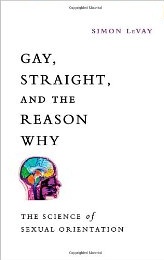 Simon LeVay’s Gay, Straight, and the Reason Why is not exactly a follow-up to his 1996 Queer Science: The Use and Abuse of Research into Homosexuality. In the earlier work, while covering biological research into the possible origins of sexual orientation, LeVay also treated the history of sex research, addressed social constructionism, and discussed a variety of social and political issues facing GLBT people and the consequences he saw flowing from biological findings.
Simon LeVay’s Gay, Straight, and the Reason Why is not exactly a follow-up to his 1996 Queer Science: The Use and Abuse of Research into Homosexuality. In the earlier work, while covering biological research into the possible origins of sexual orientation, LeVay also treated the history of sex research, addressed social constructionism, and discussed a variety of social and political issues facing GLBT people and the consequences he saw flowing from biological findings.
Gay, Straight, and the Reason Why focuses almost entirely on summarizing biological research to date on sexual orientation. LeVay presents, evaluates, and ultimately attempts to integrate work from the 1990s onward (including very recent studies) on sex hormones, genes, brain differences, physiological differences, and birth order (“the older brother effectâ€). His conclusion is that the prenatal influences of sex hormones, likely facilitated or aided by genetic factors, are the strongest candidates for determining, or strongly influencing, sexual orientation.
Those who believe that gender is largely, if not entirely, a social construct will be turned off by the centrality of the notions of gender-typical and gender-atypical behavior, for although the terms “typical†and “atypical†may be used in other contexts to refer to statistical norms, here the strong implication is that they are largely biologically-based differences. It is also possible that LeVay may be overstating the strength of those studies that support his general hypothesis. But even for the non-specialist (to whom I imagine this book is primarily addressed) who reads carefully, it is clear that most of the conclusions reached in specific studies are, in fact, tentative ones often, although not always, based on small samples or having other research design problems. Such objections can, probably, be raised for almost all research that attempts to link complex human behavior to any biological basis. However, regardless of these objections, a book such as this is needed every decade or so. Biologists and neuroscientists have a right to make their case in GLBT studies and it is good to bring all the information together in one place. The book is an essential one.
Reviewed by, David Woolwine
Assistant Professor of Library Science and Reference Librarian
Hofstra University
